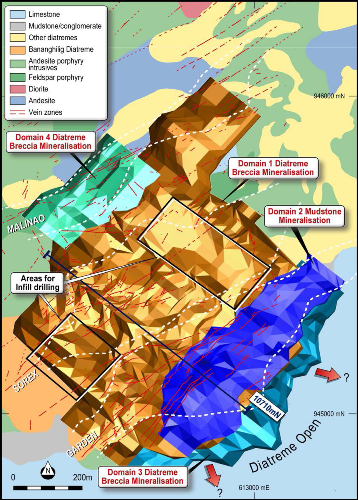Medusa Mining Limited (“Medusa” or the “Company”), through its Philippines operating company Philsaga Mining Corporation announces the update of the JORC compliant Mineral Resource estimation for the Bananghilig Gold Deposit.
 Bananghilig geology map showing a projection of the resources to surface and cross-section line 10170N.
Bananghilig geology map showing a projection of the resources to surface and cross-section line 10170N.
Following the completion of infill drilling last year (as reported on 21 November 2012), the inferred resource reported on 28 August of 1,100,000 ounces at a grade of 1.63 g/t gold contained in 21,000,000 tonnes of ore using a lower cut-off of 0.8 g/t gold has been re-classified using the same 0.8 g/t lower cut-off and depleted for artisanal workings as follows:
An additional 14 infill holes are commencing to convert additional Inferred Resources to Indicated Resources.
Following completion of this second phase of infill drilling, an updated resource estimate will be reported with the annual resource updates in July to August 2013.
The above Indicated Resource estimate will be used for Feasibility Studies.
Peter Hepburn-Brown, Managing Director of Medusa commented:
“The resource conversion has been very good where drilling densities are sufficient. The conversion of Inferred Resources to Indicated Resources is re-commencing with an additional 14 holes planned. A new Indicated-Inferred Resource estimate will subsequently be undertaken and published in the September quarter of this year with the annual resource statement.
It is pleasing to note that the Company’s Indicated Resources now total 1,323,000 ounces and the Inferred Resources total 1,776,000 ounces.
Background
The Bananghilig Gold Deposit within the Tambis District is operated under a Mining Agreement with Philex Gold Philippines Inc. over Mineral Production Sharing Agreement (“MPSA”) MPSA-344-2010-XIII which covers 6,262 hectares.
In the 1980s and 1990s a large amount of diamond and reverse circulation drilling totalling 29,477 metres in 344 holes was undertaken by various explorers to investigate a large area of known mineralisation.
From 2005 to 2007, Philsaga undertook underground exploration through a 50 metre deep shaft and development, adits, and underground and surface drilling totalling 7,715 metres in 31 holes.
From July 2010 to 21 November 2012, the Company has completed 258 holes for 78,873 metres of diamond drilling.
Resource estimation
A global Inferred Resource estimation for Bananghilig was undertaken by Cube Consulting Pty Ltd of Western Australia and announced on 28 August 2012 based on drilling results available to 31 July 2012, including a substantial amount of the 2012 infill drilling.
A small amount of drilling was subsequently completed as announced on 21 November 2012 which confirmed the geological and grade model, but has not yet been incorporated into the resource estimate.
Since October 2012, detailed surveying and plotting of artisanal mine workings has been undertaken to facilitate an estimate for depletion. Four areas of intense mine workings have been defined and all Selective Mining Unit (“SMU”) blocks within these volumes, above the water table and greater than 5 g/t gold have been depleted.
A re-classification of the 28 August 2012 resource estimate has been completed incorporating the artisanal depletion, and has highlighted two areas within the model requiring an additional 14 drill holes to upgrade the resource category in these areas. The 14 current new holes and the post 31 July 2012 drilling will be incorporated into a new resource estimate for the annual resource update in the September 2013 quarter.
The projection of the resources to surface is shown in Figure 1 overlaying the geology map, and a cross-section through the deposit is shown in Figure 2 where each coloured dot represents a block size of 5 metres by 5 metres by 2 metres.
Assaying for silver is incomplete and will be included in the annual resource update in the September quarter.
As outlined in the 28 August 2012 resource announcement, the Bananghilig Mineral Resource estimate is based on a number of factors and assumptions, some of which are listed below:
- All available drilling data as at 31 July 2012 was used for the Mineral Resource estimate.
- Wireframes were generated on plan and cross sectional interpretations based on available geology and assay data available. A lower cut off of approximately 0.3 g/t Au was used to define 4 mineralised envelope domains, Diatreme Breccia Mineralisation Domains 1, 2 and 3, and Mudstone Mineralisation Domain 2.
- Upper cuts were applied to the 2 metre composites prior to grade estimation. Top cuts used included 30 g/t for Domains 1 and 2, 10 g/t for Domain 3 and 5 g/t for Domain 4.
- The bulk densities used range from 1.8 to 2.76 t/m3 depending on the modelled lithology. A total of 2,562 bulk density measurements have been completed.
- The Resource has been estimated using Ordinary Block Kriging and Uniform Conditioning (“UC”). UC is a mathematical method that allows the discrimination of ore and waste at an assumed selective mining unit size within an estimated panel of significantly larger size. In theory, this provides a more correct prediction of estimated resource grade and tonnes above a cut off than an ordinary block kriging alone. The method draws information from the composite data variogram model and Krige’s Relationship.
- The application of the UC technique at Bananghilig is based on the premise that mining would be by open pit extraction. A Selective Mining Unit (“SMU”) of 5 metres by 5 metres by 2 metres was evaluated within ordinary kriged panels Y = 25 metres; X = 25 metres and Z = 4 metres for the purposes of reporting recoverable resources.